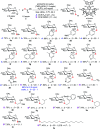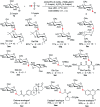Direct, stereoselective thioglycosylation enabled by an organophotoredox radical strategy
- PMID: 34094490
- PMCID: PMC8163235
- DOI: 10.1039/d0sc04136j
Direct, stereoselective thioglycosylation enabled by an organophotoredox radical strategy
Abstract
While strategies involving a 2e- transfer pathway have dictated glycosylation development, the direct glycosylation of readily accessible glycosyl donors as radical precursors is particularly appealing because of high radical anomeric selectivity and atom- and step-economy. However, the development of the radical process has been challenging owing to notorious competing reduction, elimination and/or SN side reactions of commonly used, labile glycosyl donors. Here we introduce an organophotocatalytic strategy through which glycosyl bromides can be efficiently converted into corresponding anomeric radicals by photoredox mediated HAT catalysis without a transition metal or a directing group and achieve highly anomeric selectivity. The power of this platform has been demonstrated by the mild reaction conditions enabling the synthesis of challenging α-1,2-cis-thioglycosides, the tolerance of various functional groups and the broad substrate scope for both common pentoses and hexoses. Furthermore, this general approach is compatible with both sp2 and sp3 sulfur electrophiles and late-stage glycodiversification for a total of 50 substrates probed.
This journal is © The Royal Society of Chemistry.
Conflict of interest statement
There are no conflicts to declare.
Figures






Similar articles
-
Catalytic and Photochemical Strategies to Stabilized Radicals Based on Anomeric Nucleophiles.J Am Chem Soc. 2020 Jun 24;142(25):11102-11113. doi: 10.1021/jacs.0c03298. Epub 2020 Jun 10. J Am Chem Soc. 2020. PMID: 32479072 Free PMC article.
-
Glycosyl Cross-Coupling of Anomeric Nucleophiles: Scope, Mechanism, and Applications in the Synthesis of Aryl C-Glycosides.J Am Chem Soc. 2017 Dec 13;139(49):17908-17922. doi: 10.1021/jacs.7b08707. Epub 2017 Nov 30. J Am Chem Soc. 2017. PMID: 29148749 Free PMC article.
-
Venturing beyond Donor-Controlled Glycosylation: New Perspectives toward Anomeric Selectivity.Acc Chem Res. 2018 Mar 20;51(3):628-639. doi: 10.1021/acs.accounts.7b00449. Epub 2018 Feb 22. Acc Chem Res. 2018. PMID: 29469568 Review.
-
Recent Advances in First-Row Transition Metal-Catalyzed Reductive Coupling Reactions for π-Bond Functionalization and C-Glycosylation.Acc Chem Res. 2023 Nov 21;56(22):3292-3312. doi: 10.1021/acs.accounts.3c00531. Epub 2023 Nov 2. Acc Chem Res. 2023. PMID: 37917928
-
Recent development of stereoselective C-glycosylation via generation of glycosyl radical.Carbohydr Res. 2022 Dec;522:108677. doi: 10.1016/j.carres.2022.108677. Epub 2022 Sep 17. Carbohydr Res. 2022. PMID: 36193593 Review.
Cited by
-
Why is thiol unexpectedly less reactive but more selective than alcohol in phenanthroline-catalyzed 1,2-cis O- and S-furanosylations?Org Biomol Chem. 2025 Jan 2;23(2):328-342. doi: 10.1039/d4ob01593b. Org Biomol Chem. 2025. PMID: 39575458 Free PMC article.
-
Facile access to C-glycosyl amino acids and peptides via Ni-catalyzed reductive hydroglycosylation of alkynes.Nat Commun. 2021 Aug 13;12(1):4924. doi: 10.1038/s41467-021-25127-z. Nat Commun. 2021. PMID: 34389709 Free PMC article.
-
Dehydroxylative radical N-glycosylation of heterocycles with 1-hydroxycarbohydrates enabled by copper metallaphotoredox catalysis.Nat Commun. 2024 Apr 22;15(1):3401. doi: 10.1038/s41467-024-47711-9. Nat Commun. 2024. PMID: 38649350 Free PMC article.
-
Transformations of carbohydrate derivatives enabled by photocatalysis and visible light photochemistry.Chem Sci. 2024 Jan 2;15(4):1204-1236. doi: 10.1039/d3sc05400d. eCollection 2024 Jan 24. Chem Sci. 2024. PMID: 38274059 Free PMC article. Review.
-
Exploring Photoredox Catalytic Reactions as an Entry to Glycosyl-α-amino Acids.ACS Omega. 2024 Oct 30;9(45):45437-45446. doi: 10.1021/acsomega.4c07412. eCollection 2024 Nov 12. ACS Omega. 2024. PMID: 39554407 Free PMC article.
References
-
- Rudd P. M. Elliot T. Cresswell P. Wilson I. A. Dwek R. A. Science. 2001;291:2370. doi: 10.1126/science.291.5512.2370. - DOI - PubMed
- Davis B. G. Chem. Rev. 2002;102:579. doi: 10.1021/cr0004310. - DOI - PubMed
- Doores K. J. Gamblin D. P. Davis B. G. Chem.–Eur. J. 2006;12:656. doi: 10.1002/chem.200500557. - DOI - PubMed
- Lowe J. B. Cell. 2001;104:809. doi: 10.1016/S0092-8674(01)00277-X. - DOI - PubMed
-
- Thayer D. A. Yu H. N. Galan M. C. Wong C.-H. Angew. Chem., Int. Ed. 2005;44:4596. doi: 10.1002/anie.200500090. - DOI - PubMed
- Pachamuthu K. Schmidt R. R. Chem. Rev. 2006;106:160. doi: 10.1021/cr040660c. - DOI - PubMed
- Rye C. S. Withers S. G. Carbohydr. Res. 2004;339:699. doi: 10.1016/j.carres.2003.12.011. - DOI - PubMed
- Amso Z. Bisset S. W. yang S.-H. Harris P. W. R. Wright T. H. Navo C. D. Patchett M. L. Norris G. E. Brimble M. A. Chem. Sci. 2018;9:1686. doi: 10.1039/C7SC04383J. - DOI - PMC - PubMed
-
- Schwarz S. Shen J. Kadlec K. Wang Y. Michael G. B. Feßler A. T. Vester B. Cold Spring Harb. Perspect. Med. 2016;6:a027037. doi: 10.1101/cshperspect.a027037. - DOI - PMC - PubMed
- Oman T. J. Boettcher J. M. Wang H. Okalibe X. N. van der Donk W. A. Nat. Chem. Biol. 2011;7:78. doi: 10.1038/nchembio.509. - DOI - PMC - PubMed
- Hsieh Y. S. Y. Wilkinson B. L. O'Connell M. R. Mackay J. P. Matthews J. M. Payne R. J. Org. Lett. 2012;14:1910. doi: 10.1021/ol300557g. - DOI - PubMed
- Biswas S. Garcia De Gonzalo C. V. Repka L. M. van der Donk W. A. ACS Chem. Biol. 2017;12:2965. doi: 10.1021/acschembio.7b00819. - DOI - PMC - PubMed
-
- Comber R. N. Friedrich J. D. Dunshee D. A. Petty S. L. Secrist J. A. Carbohydr. Res. 1994;262:245. doi: 10.1016/0008-6215(94)84182-9. - DOI - PubMed
- Mangte D. V. Deshmukh S. P. Heteroat. Chem. 2007;18:390. doi: 10.1002/hc.20310. - DOI
- El-Sayed W. A. Fathi N. M. Gad W. A. El-Ashry E. S. H. J. Carbohyd. Chem. 2008;27:357. doi: 10.1080/07328300802262778. - DOI
Grants and funding
LinkOut - more resources
Full Text Sources

